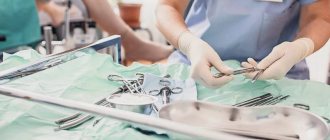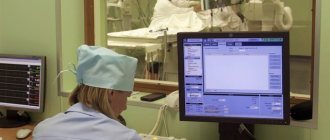To the reference book Diagnosis of vestibular function is carried out through rotational and caloric tests, as well as flank gait, Romberg position and other studies.
Author:
- Sadykhov Rahim Agalarovich
ENT pathology expert
3.00 (Votes: 2)
Diagnosis of vestibular function - identification of spontaneous symptoms of pathologies of the inner ear, the degree of excitability of the vestibular apparatus. Experimental tests are carried out to help determine what causes the symptoms - damage to the labyrinth or parts of the brain.
Symptoms
Such studies are resorted to when:
- dizziness (this symptom can be a sign of various pathologies, for example, with damage to the labyrinth, patients can often describe in detail the nature of dizziness, including indicating the exact direction of rotation of objects, position of the head and body, etc.);
- vegetative symptoms (in addition to dizziness, the subjects complain of nausea, which can be replaced by vomiting, increased sweating, pale skin, changes in pulse rates, etc.);
- spontaneous nystagmus (one of the most important symptoms, represents oscillatory movements of the eyeballs, which can be fast or slow, develops due to a disruption of impulses coming from the labyrinths to the nerves).
Along with this, typical markers of dysfunction of the vestibular apparatus are imbalance and unsteady gait.
Preparation for vestibulometry
The use of alcohol, psychotropic, narcotic and sedatives 3 days before the study is contraindicated (warn the doctor conducting the study if you are forced to take such drugs for medical reasons).
We also ask our patients not to use cosmetics.
(eyeshadow and mascara) if you are prescribed vestibulometry, as this may make it difficult to video record eye movements.
We also remind you that in our clinic it is possible to conduct a study of the function of the vestibular apparatus upon admission to educational institutions of the Ministry of Internal Affairs and the Ministry of Emergency Situations of Russia, as well as during employment.
The study is carried out by appointment! The duration of the study is about 40 minutes.
Types of diagnostics
To diagnose vestibular function in otolaryngology, the following types of studies are used:
Romberg pose
Named after the German professor of internal medicine MH Romberg, this position involves the subject taking a vertical position, feet together, arms extended forward, eyes closed.
The method allows you to identify changes in balance when vision is turned off. Depending on the causes and severity of the violations, a person in this position begins to stagger and may even fall. In the latter case, we are talking about the so-called Romberg symptom, which indicates possible damage to the cerebellum, dysfunction of the vestibular analyzer, damage to the spinal cord, the development of polyneuritis, etc.
If it is not possible to detect violations in this way, the study can be modified and complicated, for example, the patient is asked to place his feet one after the other, keeping a straight line.
Flanking gait
When performing this test, the subject moves to the sides, placing one leg next to the other. The eyes remain closed. This study is of great diagnostic value in cases of suspected cerebellar pathologies, since it is often impossible to perform these movements in such clinical cases. Damage to the labyrinth does not make any changes in the flanking gait.
Rotational test
This method's main task is to identify the functional state of the labyrinth, which helps determine the location of the pathological process. The subject sits in a chair with a manual or electric drive and is fixed. The head is slightly tilted forward and down.
After which the doctor sets the chair in motion at a speed of 1 revolution per 2 seconds. After 10 revolutions, it stops abruptly, all deviations of the body, vegetative and other reactions of the patient are recorded. The same actions are performed in the opposite direction, and the obtained indicators are compared.
Caloric test
The basis of the caloric test, as well as the rotational test, is the study of nystagmus, which allows you to assess the functionality of the labyrinth. But in this case, hot or cold water is used as an irritant, which is introduced into the external auditory canal.
Normally, nystagmus appears after 5-10 seconds and lasts 1-2 minutes. One ear is examined first, then the other. The indicators are recorded and compared, and based on the data obtained, overexcitation or, conversely, depression of the labyrinth is diagnosed.
After comparing the results of the last two tests, the doctor sees an objective picture that reveals the degree of irritation of the vestibular apparatus and serves as a fundamental basis for the subsequent differentiation of diseases of the vestibular analyzer.
Stages of research of the vestibular apparatus
Tests with outstretched arms
The tonic reaction of hand deviation is examined when performing the Barany pointing test (or finger-nose test) or a test with outstretched arms. In a normal state of the labyrinth, the patient falls into the doctor’s fingers (into his nose); in case of a labyrinth disorder, he misses with both hands in the direction opposite to the direction of the nystagmus; in case of damage to the cerebellum, the patient misses with one hand (on the affected side) in the affected side. With vestibular disorders, a pronounced extension of the hands occurs, with the hand on the side of the excited labyrinth rising upward, and on the side of the depressed labyrinth downward.
Sustainability research
The next stage is a study of stability in the Romberg position (the subject stands with his arms extended at his sides, feet clasped together and eyes closed). A healthy person will stand straight, but a patient with vestibular dysfunction will lean to the side. If the function of the labyrinth is impaired, the subject will fall in the direction opposite to the direction of the nystagmus.
Adiadochokinesis
Adiadochokinesis is a specific symptom of cerebellar disease. The examinee, in any position convenient for him, performs supination and pronation (diadochokinesis) with both arms extended forward. If the function of the cerebellum is impaired, a sharp lag of the hand (adiadochokinesis) on the affected side is observed.
Walking in a straight line.
The subject, with his eyes closed, takes 5 steps forward in a straight line and, without turning, five steps back. If the function of the vestibular analyzer is impaired, the subject deviates from a straight line in the direction opposite to nystagmus; if the cerebellum is impaired, it deviates in the direction of the lesion.
Possible causes of dizziness
Most often, patients suffer from BPPV (benign paroxysmal positional vertigo). It usually occurs due to the displacement of calcium crystals in the inner ear. They roll with sudden movement and cause a sensation of rotation.
Also common causes of dizziness are Meniere's disease (fluid accumulation and increased pressure in the membranous labyrinth) and inflammatory diseases - in particular, vestibular neuritis and labyrinthitis.
Dizziness is true (systemic), when a person seems to be spinning in space or the space around him. And false (non-systemic), when there is no sense of rotation. The latter is a negative conditioned reflex developed by the brain to some action. A psychiatrist can help you cope with this.
How is vestibulometry performed?
During vestibulometry, the patient must follow with his eyes a moving target. At the same time, all eye movements are recorded using infrared video cameras, mounted in special large glasses that the person puts on before the procedure. All moments are recorded in detail and read by a computer. This is what helps doctors gain a complete understanding of the structure of the vestibular apparatus and its work. Reaction speed and accuracy of eye movements are assessed. The doctor then performs other vestibular tests.
Contraindications for the study
Best materials of the month
- Coronaviruses: SARS-CoV-2 (COVID-19)
- Antibiotics for the prevention and treatment of COVID-19: how effective are they?
- The most common "office" diseases
- Does vodka kill coronavirus?
- How to stay alive on our roads?
It is contraindicated to perform vestibular tests, especially rotational manipulations, with intracranial hypertension, in the acute period with traumatic brain injury and acute cerebrovascular accident, during severe cardiovascular diseases.
Vestibulometry methods
There are several varieties of this procedure, each of which is characterized by certain features. The basis of the techniques is the process of irritation of vestibular receptors. They help the doctor make the correct diagnosis and determine further treatment tactics:
- Caloric test - slow infusion of water with a syringe into Zhanna’s ear canal (water temperature 40 degrees or more often cold - 18 degrees). Accordingly, both thermal and cold calorization can be carried out. To evaluate the sample, it is necessary to determine the time of completion of the procedure before the occurrence of nystagmus. Normally this time is from 25 to 30 seconds. The duration of the nystagmus itself is also determined. Normally for healthy patients this is from 50 to 70 seconds. If the eardrum is perforated, a caloric test is not permitted.
- The purpose of rotary chair testing is to determine if there is any pathology in the inner ear or brain. The test is carried out on a special rotating chair. The patient stands upright, eyes closed, head tilted down, feet on a stand, and hands on the armrests. 10 uniform rotations are performed to the right, then to the left. Rotation speed – 1 revolution for 2 seconds. After the chair stops, the person will try to focus his gaze. We need to start counting down the time. The doctor must determine the duration and severity of nystagmus. Normally, involuntary eye movements last about 30 seconds. An increase in time indicates an increase in the excitability of the labyrinth, a decrease indicates partial or complete suppression.
- The pressor test or pistol symptom condenses (or vacuums) the air in the ear canal using a rubber bulb or a special cylinder. The resulting nystagmus indicates the presence of a fistula in the semilunar canal. As a rule, the test is positive in case of chronic protracted inflammatory processes in the middle ear.
- Wojciech's otolith reaction is performed on a rotating chair. The patient tilts his head 90 degrees and closes his eyes. Then do 5 rotations for 10 seconds. Then there is a 5-second pause and the patient is asked to raise his head and open his eyes. Severe body deviation and autonomic symptoms (nausea, cold sweat, dizziness, and others) indicate an increase in vestibular-vegetative sensitivity. The reaction of the otolithic apparatus is tested when professional selection is needed for work where it is necessary to maintain balance in difficult conditions.
- With stabilometry, static balance is objectively assessed. This highly sensitive method helps to detect vestibular pathologies at the earliest stages, even when the patient has no complaints. The person being studied is placed on a platform, and the computer records every fluctuation in the center of gravity of the body in various planes. Next, the information is processed and the results of the study are processed.
Since there are 5 individual motion sensors in each ear, and most of the tests described above relate to only one of them (the lateral semicircular canal), there is obviously plenty of room for new tests. Theoretically, 4/5 of the inner ear could be destroyed, but traditional vestibular testing may not detect this.
Considering the first trials in the field of vestibulometry, little progress has been made over the past 20 years. Essentially, this is because no one has developed a practical way to stimulate individual vertical semicircular canals (the caloric test does this for the lateral semicircular canal). Rotary chair tests are the closest, but at best they stimulate two vertical channels on opposite sides of the head.
Finally, the entire vestibular nerve can be tested using galvanic stimulation. This is an old technique in which an electrical current is transmitted to the ear and eye movements or postural influences are recorded. This technology is currently not commercial and is quite limited because it is difficult to pass enough current into the ear without causing pain. The test may become popular when a vestibular prosthesis becomes available to replace the balance system in individuals who have had severe bilateral ear pathology.









